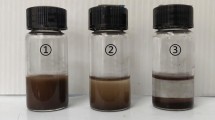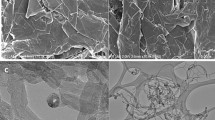Abstract
The surface tension of a liquid fuel is an important parameter in the fuel atomization process. B/JP-10 nanofluid fuels with different particle concentrations (5 mass%, 10 mass%, 15 mass% and 20 mass%) were prepared by selecting 100 nm, 300 nm and 500 nm B particles by a two-step method, in which Tween-85 was used as a surfactant. The surface tension of the above nanofluid fuels was tested at different temperatures (10–90 ℃) using the platinum plate method to investigate the effects of surfactant, temperature, particle concentration and temperature on the surface tension of B/JP-10 nanofluid fuels. The results show that the addition of surfactants helps to reduce the surface tension of the nanofluid fuel. The surface tension of the nanofluid fuel is higher than that of pure JP-10 and increases with increasing particle concentration and decreases with increasing particle size. The surface tension of the suspended fuel decreases linearly with increasing temperature in a certain temperature range (10–60 °C).












Similar content being viewed by others
References
Dagaut P, Cathonnet M. The ignition, oxidation, and combustion of kerosene: a review of experimental and kinetic modeling. Prog Energy Combust Sci. 2006;32:48–92.
Baharozu E, Soykan G, Ozerdem MB. Future aircraft concept in terms of energy efficiency and environmental factors. Energy. 2017;140:1368–77.
Zhang X, Pan L, Wang L, Zou J-J. Review on synthesis and properties of high-energy-density liquid fuels: hydrocarbons, nanofluids and energetic ionic liquids. Chem Eng Sci. 2018;180:95–125.
Balat M. Boron as an alternate engine fuel. Energy Sources Part A. 2007;29:79–83.
Gan Y, Qiao L. Combustion characteristics of fuel droplets with addition of nano and Micron-sized aluminum particles. Combust Flame. 2011;158(2):354–68.
Javed I, Baek SW, Waheed K. Autoignition and combustion characteristics of heptane droplets with the addition of aluminium nanoparticles at elevated temperatures. Combust Flame. 2015;162(1):191–206.
Kim DM, Baek SW, Yoon J. Ignition characteristics of kerosene droplets with the addition of aluminum nanoparticles at elevated temperature and pressure. Combust Flame. 2016;173:106–13.
Aberoumand S, Jafarimoghaddam A. Tungsten (III) oxide (WO3) -silver/transformer oil hybrid nanofluid: preparation, stability, thermal conductivity and dielectric strength. Alexandria Eng J. 2018;57:169–74.
Aberoumand S, Jafarimoghaddam A, Moravej M, Aberoumand H, Javaherdeh K. Experimental study on the rheological behavior of silver-heat transfer oil nanofluid and suggesting two empirical based correlations for thermal conductivity and viscosity of oil based nanofluids. Appl Therm Eng. 2016;101:362–72.
Aberoumand S, Woodfield P, Shi G, Kien Nguyen T, Nguyen H-Q, Li Q, et al. Thermo-electro-rheological behaviour of vanadium electrolyte-based electrochemical graphene oxide nanofluid designed for redox flow battery. J Mol Liq. 2021;338: 116860.
Aggarwal SK. A review of spray ignition phenomena: present status and future research. Prog Energy Combust Sci. 1998;24(6):565–600.
Chen BH, Liu JZ, Yuan JF, Zhou JH, Cen KF. Adsorption behaviour of tween 85 on nano-aluminium particles in Aluminium/JP-10 suspensions. J Nanosci Nanotechnol. 2019;19:2108–15.
Kannaiyan K, Anoop K, Sadr R. Effect of nanoparticles on the fuel properties and spray performance of Aviation Turbine Fuel. J Energy Resour Technol. 2017;139(3):032201.
Jedelský J, Jícha M. Spray characteristics and liquid distribution of multi-hole effervescent atomisers for industrial burners. Appl Therm Eng. 2016;96:286–96.
Fisher BT, Weismiller MR, Tuttle SG, Hinnant KM. Effects of fluid properties on spray characteristics of a flow-blurring atomizer. Eng Gas Turbines Power. 2017;140(4):041511.
Ojha PK, Karmakar S. Effect of silane capping on the dispersion and combustion characteristics of sub-micrometer boron particles loaded in Jet A-1. Energy Fuels. 2018;32:11010–22.
Aberoumand S, Jafarimoghaddam A. Experimental study on synthesis, stability, thermal conductivity and viscosity of Cu–engine oil nanofluid. J Taiwan Inst Chem Eng. 2017;71:315–22.
Asadi A, Aberoumand S, Moradikazerouni A, Pourfattah F, Żyła G, Estellé P, et al. Recent advances in preparation methods and thermophysical properties of oil-based nanofluids: a state-of-the-art review. Powder Technol. 2019;352:209–26.
L. Godson. Measurement of viscosity and surface tension of silver deionized water nanofluids. 37th National & 4th International Conference on Fluid Mechanics and Fluid Power, IIT Madras, Chennai, India.
Tanvir S, Qiao L. Surface tension of nanofluid-type fuels containing suspended nanomaterials. Nanoscale Res Lett. 2012;7(1):1–10.
Jeong YH, Chang WJ, Chang S. Wettability of heated surfaces under pool boiling using surfactant solutions and nano-fluids. Int J Heat Mass Transf. 2008;51(11–12):3025–31.
Pantzali MN, Kanaris AG, Antoniadis KD, Mouza AA, Paras SV. Effect of nanofluids on the performance of a miniature plate heat exchanger with modulated surface. Int J Heat Fluid Flow. 2009;30(4):691–9.
Sohel MSM, Tan SH, Nguyen NT. Temperature dependence of interfacial properties and viscosity of nanofluids for droplet-based microfluidics. J Phys D Appl Phys. 2008;41(8): 085502.
Kumar R, Milanova D. Effect of surface tension on nanotube nanofluids. Appl Phys Lett. 2009;94(7): 073107.
Sha JY, Ge HH, Wan C, Wang LT, Xie SY, Meng XJ, Zhao YZ. Corrosion inhibition behaviour of sodium dodecyl benzene sulphonate for brass in an Al2O3 nanofluid and simulated cooling water. Corros Sci. 2019;148:123–33.
Baek S, Shin D, Kim G, Lee A, Noh J, Choi B, Huh S, Jeong H, Sung Y. Influence of amphoteric and anionic surfactants on stability, surface tension, and thermal conductivity of Al2O3/water nanofluids. Case Stud Therm Eng. 2021;25:100995.
LotfizadehDehkordi B, Kazi SN, Hamdi M, Ghadimi A, Sadeghinezhad E, Metselaar HS. Investigation of viscosity and thermal conductivity of alumina nanofluids with addition of SDBS. Heat Mass Transf. 2013;49(8):1109–15.
Xiu-Tian-Feng E, Pan L, Wang F, Wang L, Zhang X, Zou J. Al-nanoparticle-containing nanofluid fuel: synthesis, stability, properties, and propulsion performance. Ind Eng Chem Res. 2016;55(10):2738–45.
Xtf E, Zhi X, Zhang Y, Li C, Zou J, Zhang X, et al. Jet fuel containing ligand-protecting energetic nanoparticles: a case study of Boron in JP-10. Chem Eng Sci. 2015;129:9–13.
Chen B, Shan S, Liu J. Evolution of solid-liquid coupling combustion characteristics of boron suspension fuel in O2/Ar Atmosphere. Combust Flame. 2022;237:111869.
Loglio G, Pandolfini P, Miller R, Makievski AV, Ravera F, Liggieri L. Drop and bubble shape analysis as a tool for dilational rheological studies of interfacial layers. Stud Interface Sci. 2001;11:439–83.
Tsay RY, Yan SC, Lin SY. A video-enhanced plate method for simultaneous measurements of surface tension and contact angle. Rev Sci Instrum. 1995;66:5065–9.
Khaleduzzaman SS, Mahbubul IM, Shahrul IM, Saidur R. Effect of particle concentration, temperature and surfactant on surface tension of nanofluids. Int Commun Heat Mass Transf. 2013;49:110–4.
Mei D, Fang Y, Zhang Z, Guo D, Chen Z, Sun C. Analysis of surface tension for nano-fuels containing disparate types of suspended nanoparticles. Powder Technol. 2021;388:526–36.
Bhuiyan MHU, Saidur R, Mostafizur RM, Mahbubul IM, Amalina MA. Experimental investigation on surface tension of metal oxide–water nanofluids. Int Commun Heat Mass Transf. 2015;65:82–8.
Li Z, Kalbasi R, Nguyen Q, Afrand M. Effects of sonication duration and nanoparticles concentration on thermal conductivity of silica-ethylene glycol nanofluid under different temperatures: An experimental study. Powder Technol. 2020;367:464–73.
Acknowledgements
This work was supported by the National Natural Science Foundation of China (CN51876187).
Author information
Authors and Affiliations
Contributions
LD involved in methodology; formal analysis; investigation; data curation; and writing—original draft. JL involved in conceptualization; writing—review and editing; and project administration. ZL involved in resources. WY involved in validation and supervision.
Corresponding author
Ethics declarations
Conflict of interest
The authors declare that they have no known competing financial interests or personal relationships that could have appeared to influence the work reported in this paper.
Additional information
Publisher's Note
Springer Nature remains neutral with regard to jurisdictional claims in published maps and institutional affiliations.
Rights and permissions
Springer Nature or its licensor (e.g. a society or other partner) holds exclusive rights to this article under a publishing agreement with the author(s) or other rightsholder(s); author self-archiving of the accepted manuscript version of this article is solely governed by the terms of such publishing agreement and applicable law.
About this article
Cite this article
Du, L., Liu, J., Li, Z. et al. Measurement and analysis of surface tension of B/JP-10 high-energy nanofluid fuels for enhanced heat transfer in combustion. J Therm Anal Calorim 148, 3851–3859 (2023). https://doi.org/10.1007/s10973-023-11957-0
Received:
Accepted:
Published:
Issue Date:
DOI: https://doi.org/10.1007/s10973-023-11957-0




